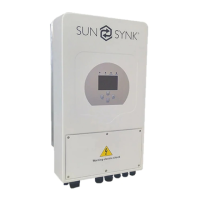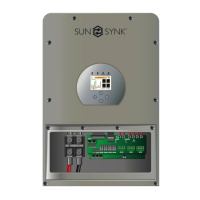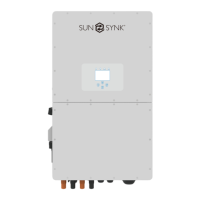Website: www.sunsynk.com E-mail: sales@globaltech-china.com
8
1.2. A SIMPLE HYBRID INVERTER
A simple way to represent a hybrid inverter is actually by an off-grid inverter with a changeover contactor
(a large relay). Many so-called hybrid inverters are standard off-grid inverters with a charger circuit and a
changeover switch, as presented in the diagram of Figure 2.
Figure 2 - Simple representation of a hybrid inverter.
The diagram presented in Figure 2 presents a basic system. However, it has many flaws. The biggest
issue with this system in residential applications is that the total power of the house must be powered through
the inverter. Therefore, if you have a peak demand of 20kW in your house, then you must install a large
capacity 20kW inverter or bigger to allow for peaks in consumption.
Also, in this type of inverters, the AC charge circuits (If any) tend to be quite small. Therefore, charging
from the AC supply will take a long time.
1.3. TYPES OF HYBRID INVERTERS
Inverters can be divided into two categories: low frequency and high-frequency inverters. These apply to
hybrid, string, and battery inverters, which have the ability to be either low-frequency or high-frequency
inverters.
High-frequency inverters fall into two categories as well:
Metal-Oxide-Semiconductor Field Effect Transistor (MOSFET) driven inverters
Insulated-Gate Bipolar Transistors (IGBTs) driven inverters.
Inverters that employ MOSFET technology are traditional high-frequency inverters, and this drive
technology is used in most professional inverters. Currently, some inverters use Silicon-Carbide MOSFETs
Sunsynk.com Sunsynk.com Sunsynk.com Sunsynk.com
Sunsynk.com Sunsynk.com Sunsynk.com Sunsynk.com
Sunsynk.com Sunsynk.com Sunsynk.com Sunsynk.com
Sunsynk.com Sunsynk.com Sunsynk.com Sunsynk.com
Sunsynk.com Sunsynk.com Sunsynk.com
Sunsynk.com Sunsynk.com Sunsynk.com
Sunsynk.com Sunsynk.com
Sunsynk.com Sunsynk.com
Sunsynk.com
Sunsynk.com
Sunsynk.com Sunsynk.com Sunsynk.com Sunsynk.com
Sunsynk.com Sunsynk.com Sunsynk.com
Sunsynk.com Sunsynk.com Sunsynk.com
Sunsynk.com Sunsynk.com
Sunsynk.com Sunsynk.com
Sunsynk.com
Sunsynk.com
